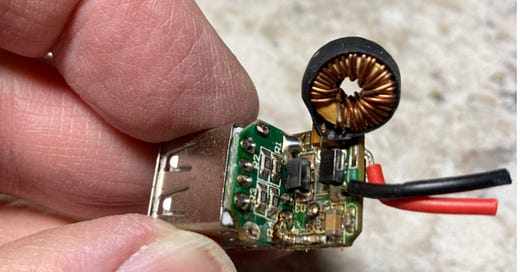Can overheating USB ports cause a fire in your RV?
I'm not sure, but these pictures sure do tell a story...
Dear Mike:
I have had three USB ports recently go out in my motorhome. After they no longer worked I noticed that they became very warm, not hot to the point of fire, but very warm. I recently replaced these myself and all is good with the world again, but I took one of the failed ports apart and noticed some heat damage. Is there a possibility that these could cause a fire since they were mounted in a wood wall?
I had no idea of the electronics behind one of these and now understand why they and so expensive ($27.). I presume they have a lifespan like everything else. These were 6 years old. Love your posts. Roger WUJEK
Dear Roger,
Thanks for the great pictures. Yes, a closeup shot of the unit does look like signs of moderate heating. And if they felt warm to the touch on the outside of the wood wall, they were certainly a lot hotter on the inside. I’m not sure it got hot enough to start a fire, but any type of heating is suspicious and not to be ignored.
But much of that discoloration could simply be due to the manufacturer inadequately removing the solder flux after wave soldering the circuit boards. And that flux tends to attract moisture and become conductive after a while. I’m guessing that’s what happened here, and it eventually cause cross-circuit current leakage and overheating. That’s why I carefully remove all flux residue from my circuit boards after soldering. I don’t want a circuit failure in the future due to flux contamination.
What to do?
Well, since this was installed by the RV builder years ago, there’s very little you can do except for replace all of them in your RV. But you should carefully inspect all the new USB ports for any signs of flux residue on the circuit boards before installing them. If there’s any flux left on the boards, you can either send them back for replacement, or clean them yourself.
Flux Be Gone…
While there are special flux removers on the market, I found that plain old isopropyl alcohol and a toothbrush does a pretty good of removing it. But if you have an electronics bench, then you're probably using something like this.
I always do flux removal in several repeated steps, and then make sure the board is completely dry before assembling and applying power.
Let’s play “spray safe out there… Mike
My next live webinar is April 3 at 3:00pm EDT!
Just a reminder about my upcoming live webinar on Wednesday, April 3 at 3:00pm eastern time. The topic is Powering your RV “off grid” without a generator!
Here’s a video preview of what I’ll be discussing. You can ask me your questions and get answers in real time. If you can’t attend, it will be available as a video replay on my RVelectricity YouTube channel. Just click on the picture below or the link HERE and you can sign up for a notification when it begins streaming.
Thanks for watching… and see you next Wednesday!










Not relative to this subject but would like to know what happened to your Weekly Digest"?
I taught electronics for 25 years. If one of my students had turned in a project with that much flux residue on it, it would have been an immediate fail and required rework.